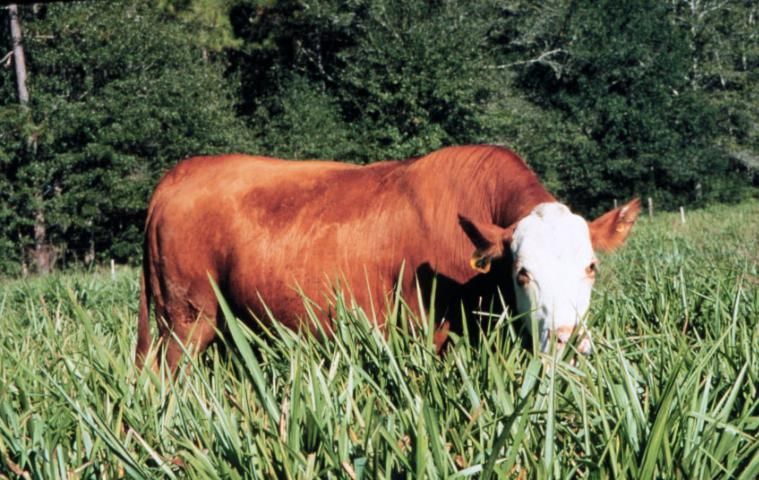Elephantgrasses were introduced into the United States from Africa in the early 1900s and were distributed to Florida farmers. These elephantgrasses were not widely used because of their tall, upright growth and large stems.
Dwarf types of elephantgrass were first discovered in the 1940s, and Mott dwarf elephantgrass was developed in the 1970s in Tifton, Georgia. Mott achieves a maximum height of about 5–6 feet compared to 12–18 feet for the tall types. Nodes (joints) on the stems of Mott are very close together (1 inch) compared to those on tall types (4–6 inches). This results in a leafy forage with a stem that stays relatively short until the plant flowers in the fall. As a result, it is not as difficult to manage for grazing. Forage of Mott is very high in nutritive value. Crude protein is generally in the range of 12%–14% when it is fertilized with 120–150 lb of nitrogen per acre per year. Digestibility is usually in the range of 65%–70%. High nutritive value is possible because the majority of the forage eaten by animals is leaf. During 3 years of experiments, yearling beef steers grazing Mott elephantgrass gained in excess of 2 lb/day over 5-month grazing periods from May to October.

Credit: Lynn Sollenberger, UF/IFAS
Mott elephantgrass is not used widely in Florida mainly because it must be planted vegetatively and the planting process is costly and not completely mechanized. Mott has potential for small family farms that can provide the labor necessary to get it established, but it is generally not practical for large enterprises. Mott elephantgrass is best adapted to well-drained, fertile or well-fertilized soils.
Establishment of Mott requires mature, well-fertilized stems that have been growing rapidly for at least 60 days. Stems are cut near soil level from the nursery area, transported to a well prepared, weed-free seedbed, put end to end horizontally in furrows, and covered with approximately 1 inch of soil. Optimum planting time is July through August. New shoots will emerge in about a week. New plants gradually form bunches of stems (tillers) and increase in diameter. They do not creep to fill in empty areas, so good initial establishment is critical. Mott is very cold tolerant and can grow in North or South Florida. The above-ground plant parts are killed by frost, but new shoots form each spring from underground rhizomes.
Mott elephantgrass can be used for grazing, green chop, or silage. It is not recommended for hay because the thick stems take too long to dry. Elephantgrass does best when there is a rest period between grazings or cuttings. Pastures should be grazed every 4–5 weeks to a stubble height of about 14–18 inches. This removes the majority of the leaf canopy but most of the stem and the growing points (apical meristems) remain intact. This is important for the long-term health of the plant and provides a diet that is more nutritious for the animal. When harvesting Mott elephantgrass, the greatest yields of leaf occur when plants are cut about every 9 weeks to a 4-inch stubble. This cutting frequency also helps the stand to remain strong and vigorous, with little reduction in nutritive value. In most cases, the digestibility of this material has been between 60% and 65%.
Mott fertilization programs should be similar to those for bermudagrass and stargrass. Nitrogen rates of 100–150 lb/acre per year work well for grazed pasture. When harvested, rates of 150–200 lb/acre per year are appropriate. Nitrogen should be split applied in spring and after each grazing or harvest except the last one of the season. Phosphorus and potassium should be added according to soil test. If soil tests indicate low levels of phosphorus and potassium, apply 40 lb/acre of P2O5 and 80 lb/acre of K2O for grazed pastures, with an additional 40–80 lb/acre of K2O for harvested areas.


